PART 3/5
Dealing with and interpreting historical sources.

(Type
Ctrl+F
to find any text on this page)
 THE
YEAR 1657
THE
YEAR 1657
In parts 1
and 2 we have identified
the main characters, mentioned in the book Innovation & Collaboration - The early
development of the pendulum clock in London
(Garnier & Hollis)(1,
based on historical facts. This third part deals with the year 1657 in which
the invention of Christiaan Huygens, the application of the pendulum in a clock
movement, was made into a working and commercial product. In addition, we will
discuss and denounce the research method that, especially from England, has
been used now for decades. It is striking, that this method always has a particular
underlying strategy: to reduce the role of Salomon Coster, and to a lesser
extent the role of Christiaan Huygens, to increase the role of the English
makers and in particular that of John or Ahasuerus Fromanteel.
As an example of this method,
we want to examine the new theory of Garnier & Hollis, based on facts, as
documented in the archives. This theory was widely promoted during the
beautiful exhibition Innovation & Collaboration, held at Bonhams in London
from 3 to 14 September 2018 and also recorded in the aforementioned book.
The
surprising conclusion of Garnier & Hollis is that John Fromanteel came from
London to The Hague to teach Salomon Coster, between September 1657 and May
1658, how to make a pendulum clock.
 THE EXPERIMENTAL PHASE
THE EXPERIMENTAL PHASE
Before we go into the story
of Garnier & Hollis first the facts at a glance: the patent for the
application of the pendulum in a clock movement was granted by the States
General to Salomon Coster on 16 June 1657.(2
With this, Coster had the (exclusive) right for 21 years to make pendulum
regulated clocks in Holland and West-Friesland. Unfortunately, the patent
application itself has not yet been found or has been lost altogether, but it
obviously had been submitted some time before the conferment on 16 June.
This implies there was only a
period of at most a few months between the actual invention of Christiaan
Huygens (December 25, 1656) and the conferment of the patent. In the
experimental phase from January 1657 to the patent application, work will have
been done to make a functioning pendulum clock. Although nowhere has been
recorded who assisted Huygens during this first phase, the most likely
candidate is Salomon Coster. After all, he was the applicant for the patent.
Also at a later stage (December 1657), during the works in the church tower of
Scheveningen, Coster was obviously the right man to call upon when it involved
experiments with pendulum movements.(3
No other clockmakers assisting Huygens are mentioned in this first period.
 THE PATENT
THE PATENT
Salomon Coster was at that
time one of the most important clock- and watchmakers in the Netherlands,
having made complicated box clocks and watches. Given the short time span
between the simple but brilliant invention of Huygens and the application of the
patent, it was apparently easy for Coster to construct four gearwheels between
two plates, a pendulum suspension and motion work. This new construction was much simpler than
the movements Coster had made so far.
After obtaining the patent in
June 1657, Coster will soon have found out that he had opened a new market and
that the expansion of labour capacity was desperately needed. He will have
sought cooperation in order to enlarge the current production and to be able to
serve the new market of the pendulum clock.
As an advanced apprentice
John Fromanteel fitted well in this picture. He was a 5th-year
apprentice, not yet a journeyman, so not yet an accomplished clockmaker. On the
other hand Fromanteel was not a starting inexperienced student, still taking up
a lot of time from Coster to teach all the principles of clockmaking, but immediately a
productive employee.
John was hired and in
September 1657 an employment agreement was drawn up for the duration of 8 to 9
months. This agreement, nowadays also known as the
Coster-Fromanteel
contract, has already for decades been a source of the most peculiar
theories.(4
When we look at the facts in
the contract, we see little more than a fixed-term employment agreement with
performance-based pay, between master clockmaker Salomon Coster and skilled
apprentice John Fromanteel.


Fig. 1
The contract
These ‘job titles’ are
historically correct, since Coster has been named as such since 1645 and John
Fromanteel, in the fifth year of his apprenticeship, was still an advanced
student, also according to the rules of the Worshipful Company of Clockmakers.
Moreover, these job titles are exactly defined in the employment agreement
between Coster and Fromanteel. The work of skilled apprentice Fromanteel takes
place in the workshop of the master clockmaker Coster and a pay rate per piece
is agreed. On the basis of either the currently still existent Coster pendulum
clocks, or archival documents, it is not possible to determine who did what in
the production process. Even the agreement between Coster and Fromanteel only
mentions the general words "werck" and "orlogiewerck" (i.e.
movement or clock/watch movement), which implicates that any type of movement
could be meant. However, it is becoming increasingly clear that the Coster
workshop had a much larger production than was thought for a long time, and
that also several other clockmakers were working for Coster.(5
Many stories have been
written and thoughts expressed zooming in on the smallest parts (even up till
collet level!). Just the same, we will stay away from these micro level discussions, because
evidence on who did what exactly, can never be delivered.
It would be better to have
the metal and wood of the clocks scientifically examined by experts using the
most modern equipment.
If scientifically proven
authentic, the fact that these are Salomon Coster clocks is evident, just
because the clocks are signed with his name, just as
The Nightwatch was
signed by Rembrandt, being a collaboration of several painters under the wings of
the master. Or a Fromanteel signed clock, on which several clockmakers will
have participated.
Other matters in the agreement,
such as the supply of materials, explaining single phrases, points and commas
in the text, can all be interpreted in various ways, but without additional
irrefutable evidence, they are good for a rainy afternoon discussion, but
scientifically uninteresting.
One good example of the lack
of historical knowledge and thorough research in these discussions is the fact
that by some authors a lot of significance and various explanations are
attributed to the numerous erasures in the agreement between Coster and Fromanteel.
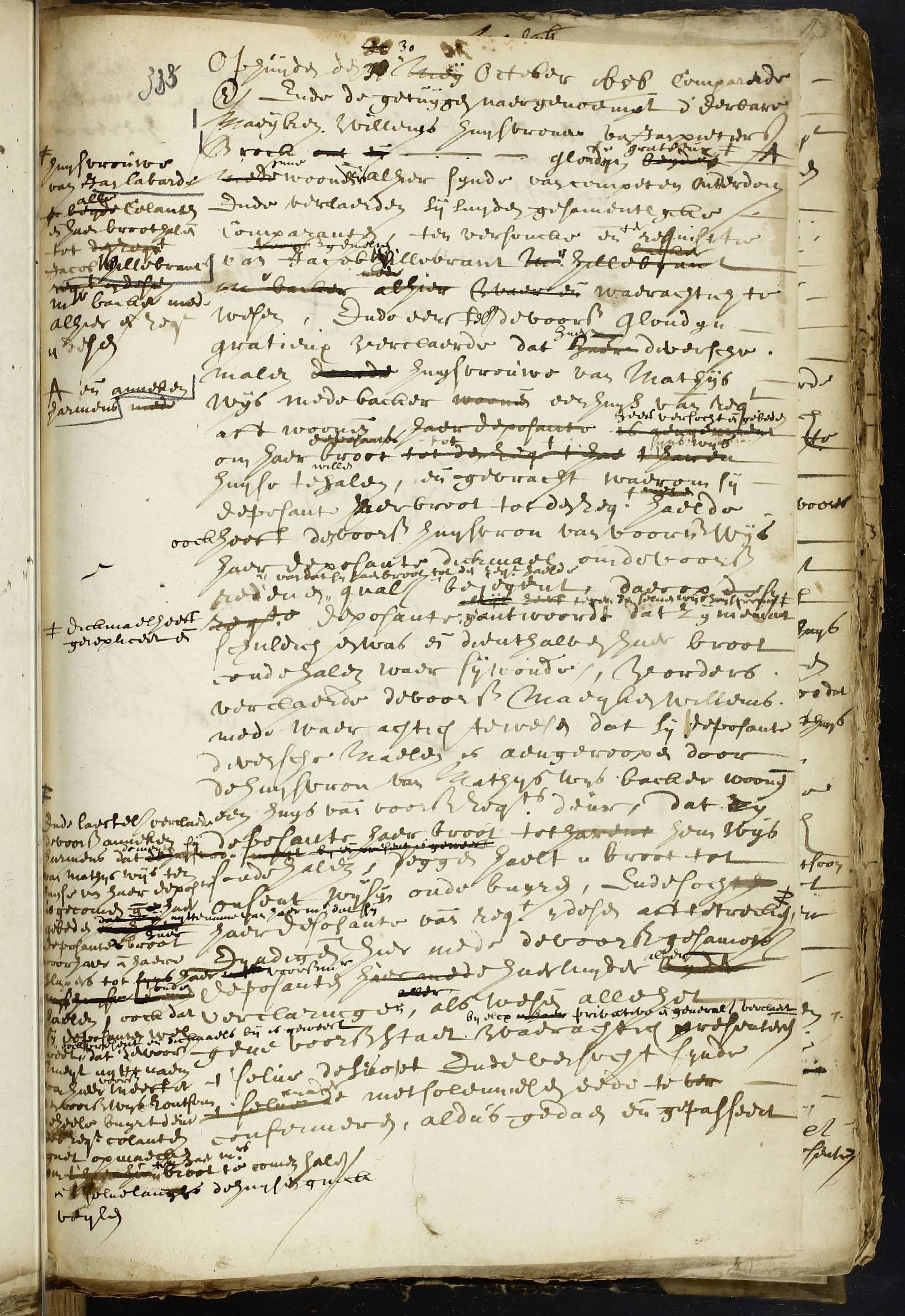
fig. 2
Same notary book more erasures
If these authors would simply
study the same notary book, or other 17th century Dutch notarial
protocols, they would see that many deeds contain the same number or even more erasures
(Fig. 2). Unfortunately, this is conveniently overlooked here.
Nevertheless, in the absence
of any important and unambiguous English archives about the first pendulum
clocks, especially our English clock friends for decades now are trying to find
evidence in this contract in favour of Fromanteel in particular.
Whereas previous English
speculations assumed an important role for John Fromanteel in the manufacture
of the first pendulum clocks, Garnier added a new chapter to the
Coster-Fromanteel discussion in the book Innovation & Collaboration.
In chapter 3, Garnier & Hollis try to build a story in which is stated that
apprentice John Fromanteel came to The Hague to explain to master clockmaker
Coster, in eight to nine months, how to make a pendulum clock. At critical
moments, where the reader expects an important archive piece or other
conclusive evidence, remarkably often the words "suggest",
"maybe" and "strongly possible" are used.
Although we stick to archival
documents as much as possible, it sometimes is unavoidable to propose a highly
probable theory. Be that as it may, this theory then must be firmly supported
by facts. When a theory aims to demonstrate a major change in historiography,
the evidence must be strong and conclusive.
As an example: in
Tijdschrift
18/2(6
it is said that the brother of Jannetje Hartloop (Coster's wife) presumably
learned the trade at Coster’s. The proof for this is not conclusive, but it is
plausible. Moreover, and this is important, it is a theory that does not turn
history upside down.
When the attribution of the
first pendulum clocks and the role during the experimental phase is moved from
Coster to Fromanteel, this is of a different order and the evidence must be
strong and supported by multiple archival records.
In their book, Garnier &
Hollis have proclaimed the remarkable theory that Fromanteel taught the making
of a pendulum clock to Coster, instead of the other way around. For this conclusion
they use the following structure:
1.
The weight driven clocks with seconds
indication were the basis of the patent application. Thuret(I was the one
who assisted Huygens in this experimental period and in the first quarter of
1657 was responsible for making the pendulum clocks driven by weights.
2.
In
Horologium (1658) Huygens speaks
about 'manufacturers'. This word is in the plural, so if Thuret assisted
Huygens, there must have been another clockmaker assisting Huygens in this
experimental phase. Who was this other clockmaker?
3.
The Coster-Fromanteel agreement has a
sensational phrase that shows that Fromanteel demonstrates the making of a
pendulum clock to Coster, instead of the other way around.
4.
In addition to Thuret, Fromanteel therefore
was the other one assisting Huygens in the experimental phase of the pendulum
clock. Where Thuret was responsible for the weight driven clocks, Fromanteel
was responsible for the ‘commercial’ spring driven movements.
endsection
In the run-up to Garnier
& Hollis' new discovery in the Coster-Fromanteel agreement (more on this
later in this article) they immediately make a huge mistake. They state that we
should realise that a weight driven clock with a seconds indication was the
basis for the patent application. The main shortcoming is, the patent
application has so far not been found in the archives and the grant of the patent
itself does not mention a weight clock.
End
of this section, click
here to continue.

 NOTES NOTES
|
|
|
|
I |
Isaac Thuret ca. 1630 – 1706),
horloger ordinaire du roi,
was one of the most productive makers in Paris in the 2nd half of
the 17th century. He was also the clockmaker responsible for the
maintenance of the machines of the
Académy des Sciences and the
Paris observatory. In 1675, Christiaan Huygens asked the help of Thuret to
produce the first spiral spring watch. In January 1686, Thuret moved
into the ‘Galleries du Louvres’. |
|
II |
‘Ingevolge de bevoegdheid in het Koninklijk Besluit van 23
augustus 1907 Staatsblad no. 237), gegeven aan gemeenten, die aan zekere
voorwaarden voldoen, om de archieven van de notarissen, die hun standplaats
binnen die gemeenten gehad hebben, van het Rijk in bewaring te ontvangen, heeft
de gemeente 's-Gravenhage in november 1910 alle archieven van op haar toenmalig
grondgebied geresideerd hebbende notarissen over de jaren 1597-1811 op haar verzoek
in bruikleen ontvangen.’ |
|
III |
‘sal indemneeren ende vrijhouden van bier, vuur ende licht’
|
|
|
|
|
1 |
Richard Garnier & Leo Hollis, Innovation & Collaboration,
The early development of the pendulum clock in London, Fromanteel Ltd., Isle of
Man, 2018 |
|
2 |
Nationaal Archief, tnr. 3.01.04.01, Staten van Holland, inv.nr. 1611, nr. 22,
d.d. 16-07-1657. |
|
3 |
O.a. in Oeuvres Complètes de Christiaan Huygens, Tome
Deuxième, correspondance 1657-1659. p. 108. Nr. 433. |
|
4 |
Haags Gemeentearchief, tnr. 0372-01, Notarieel archief Den Haag, inv.nr. 322,
folio 409. |
|
5 |
Although it was drafted two years later,
the estate statement, drawn up immediately after Salomon Costers' death, shows
that there was a huge stock in the Coster workshop and that Coster also
outsourced work to Severijn Oosterwijck. See: Victor Kersing and Rob
Memel, ‘In de voetsporen van Salomon Coster. Van Hagestraat naar
Wagenstraat’ in: TIJDschrift 18/2. p. 4-9. |
|
6 |
Kersing en Memel, ‘In de voetsporen van Salomon Coster Van Hagestraat naar
Wagenstraat’ in: TIJDschrift 18/2. p. 4-9. |
|
7 |
Translation from
Tijdschrift voor horlogemakers, 1
maart 1903. |
|
8 |
O.a. in
Going Dutch. The invention of the pendulum clock. Proceedings
of a symposium at Teylers Museum, Haarlem, 3 december 2011 Zaandam,
2013). p. 29. |
|
9 |
For more on this topic and Thuret see part
4 of these articles: Part 4: The invention of the pendulum clock – The
Sequel, more inventions. |
|
10 |
Haags Gemeentearchief, tnr. 0372-01, Notarieel archief Den Haag, inv.nr. 322,
folio 409. |
|
11 |
Richard Garnier & Leo Hollis, Innovation & Collaboration,
The early development of the pendulum clock in London, Fromanteel Ltd., Isle of
Man, 2018, pp. 67 |
|
12 |
Richard Garnier & Leo Hollis, Innovation & Collaboration,
The early development of the pendulum clock in London, Fromanteel Ltd., Isle of
Man, 2018, pp. 68 |
|
13 |
John C. Taylor,
The Salomon Coster John Fromanteel contract 3rd
september 1657. Changes made during drafting s.l., s.a.). |
|
14 |
John C. Taylor, The Salomon Coster John Fromanteel contract 3rd
september 1657. Changes made during drafting s.l., s.a.), pp. 2 point E. |
|
15 |
H. Brugmans, ‘Uit de protocollen der Haagsche notarissen’ in:
Die Haghe.
Bijdragen en mededeelingen 1908, p. 1-124; H. Brugmans, ‘Uit de protocollen
der Haagsche notarissen II’ in: Die Haghe. Bijdragen en mededeelingen
1909,
p. 1-78; H. Brugmans, ‘Uit de protocollen der Haagsche notarissen III’ in:
Die
Haghe. Bijdragen en mededeelingen
1910, p. 1-113. |

|
Garnier & Hollis then
draw a wrong conclusion from Horologium (September 1658)(Fig.
3). Huygens
writes in his concluding speech about the uniformity and the firmness of the
pendulum.
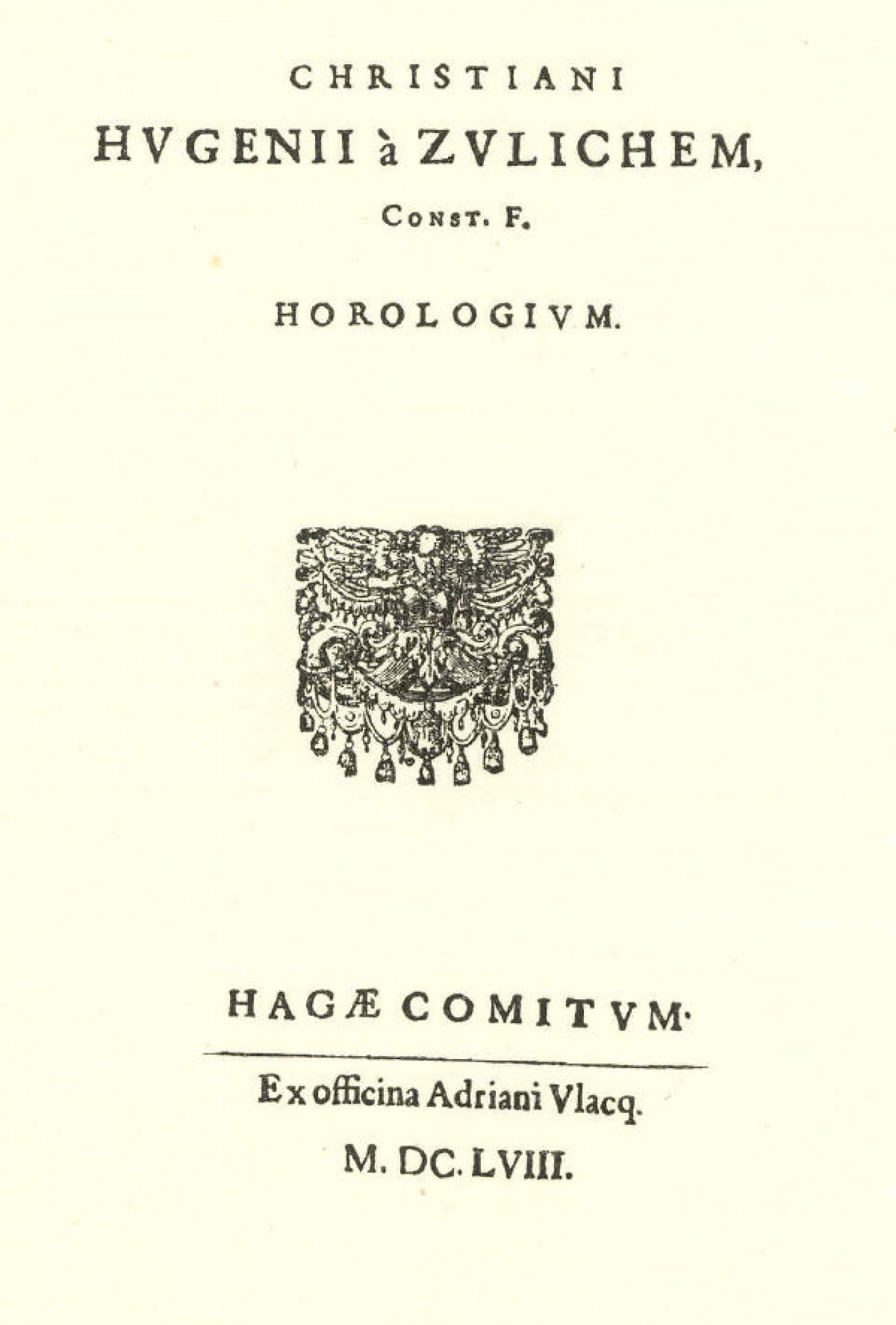
Fig 3. Horologium
The translation(7
from Latin is as follows:
‘Much that I could add to this, I leave to
the ingenuity of the manufacturers, who, once they have understood my
invention, can easily find out how it can be applied to the different types of movements
and also to those that have been made according to
the old system’.
Huygens concludes his
Horologium
with the remark that his invention will be further developed and that
manufacturers (among others clockmakers) will accomplish this.
Huygens also states, with the
then current insight, the existing balance/foliot movements are easily
converted to a pendulum. Huygens made this statement more than a year and a
half after his invention, after many pendulum clocks had already been produced.
Garnier & Hollis mistakenly see this as the evidence that several people
were involved during the experimental phase of the pendulum clock (early 1657).
Here the story can actually
stop, but we will take you into some other curious next steps.
Reference is made to a
publication by Sebastian Whitestone stating that Thuret was the clockmaker helping
Huygens with the experimental pendulum clocks in early 1657.
(8
However, Thuret only comes into the picture in the
Oeuvres
Complètes of Huygens from 1662 onwards. Up till now, no document has shown
Huygens knew Thuret before this date, let alone they were working together during
the early phase of the pendulum clock.
Probably, the confusion arose because the editor of
Oeuvres
Complètes, suggests in the margin of a letter from Huygens to Cha<>pelain of
20 August 1659, , Thuret may be meant by the word 'he'.
Unfortunately, the
Oeuvres Complètes do not show the
basis for this suggestion. Nor have we been able to find anything in this
regard elsewhere.do not show the
basis for this suggestion. Nor have we been able to find anything in this
regard elsewhere.
We do know some still existing wall clocks with long pendulum signed
by Thuret.(9
On the basis of various characteristics of both case and movement,
these clocks need to be dated much later than 1657.
_full-bw.jpg)
Fig. 4
Much later than 1657.
Weight driven long pendulum
wall clock by Isaac Thuret á Paris
Garnier & Hollis then return to September 1657 to explain the
new major discovery by quoting the Coster-Fromanteel agreement.
The following
sentence appears in the Coster-Fromanteel contract
soo heeft hij Coster belooft hetselve werck dat hij Fromanteel sal maecken I (ende het secreet daerinne bestaende), hem voor den voorsz. geexpereerden tijt te openbaeren, mits dat de
wercken die bij hem
Fromanteel hem op
conditien hiervooren
verhaelt sullen
sijn
gemaeckt hij Coster voor de voorbedongen prijs aen sich belooft sal
mogen ende moeten behouden.(10
This is translated to:
... Further so has he
Coster promised to reveal the same work that he Fromanteel will make (and the
secret therein existing) to him before the aforementioned expired time,
provided
that the works which by
him Fromanteel on conditions aforementioned will have been made, he Coster for
the stipulated price will be allowed and obliged to keep.(11
Or
in plain English: Coster will tell Fromanteel the secret that is in the
(pendulum) movement and Coster will also take the manufactured movements for
the pre-agreed price.
The
handwriting of notary Josua de Putter is not always clear and his commas and
other punctuation marks sometimes differ. However, Garnier & Hollis see two
punctuation marks as extra parenthesis and the text according to Garnier &
Hollis gets a completely different meaning (Fig.
5). The new sentence now
becomes (see new brackets) as follows:
soo heeft hij Coster belooft hetselve werck dat hij Fromanteel sal maecken
((ende het secreet
daerinne
bestaende), hem voor den voorsz. geexpereerden tijt te openbaeren) mits dat de
wercken die bij hem
Fromanteel op
conditien hiervooren
verhaelt sullen
sijn
gemaeckt hij Coster voor de voorbedongen prijs aen sich belooft sal mogen ende moeten
behouden.
Which then suddenly is
translated to:
... furthermore during the
aforementioned time so has he Coster contracted the same work that he
Fromanteel will make - (and the secret incorporated therein) him to explain
before
the aforementioned expired
time - provided that the works which by him Fromanteel on conditions previously
cited shall be made the same he Coster for the pre-stipulated price to
himself promised will be
allowed and obliged to keep...(12
So we see a larger part of
the sentence in brackets. In this Garnier & Hollis see proof that Coster
did not tell the secret to Fromanteel, but the other way around: Fromanteel taught
Coster how to make a pendulum clock!

Fig. 5
We, and various experts, once
again have looked at the meaning of this new sentence structure and into the
scope of the entire agreement. Unanimously we come to the conclusion that this
new theory, in which punctuation marks are seen as extra brackets, (fig. 5) does not
result in any change in the meaning of the text. In no way it is comprehensible
or possible to follow the conclusions of Garnier & Hollis.
 FACT FINDING
FACT FINDING
The tales on the new
Fromanteel story are based on far-fetched assumptions and theories. It actually
entails a recommendation to investigate in the future on the basis of facts
laid down in dated deeds and to take note of the 17th century Dutch
manuscripts, the use of language and the course of events at 17th century
notaries.
Of course one can put forward
ideas and thoughts at certain moments, but when the authors think to have made
great discoveries, as is the case with Innovation & Collaboration, they
will have to come better prepared than bring a theory built on quicksand.
 TWO G's
TWO G's
On the occasion of the exhibition
Innovation & Collaboration, Dr. John C. Taylor published and
commented a facsimile edition of the ‘Coster-Fromanteel contract’.(13

The facsimile looks beautiful
and well cared for; clearly, a lot of attention has been paid to this, as well
as to the contents of the contract itself. The document has no less than 67
notes with comments. This enormous number alone already suggests the author is
not accustomed to reading seventeenth-century Dutch notarial protocols, let
alone interpreting them. This is immediately apparent for
paragraph 1]. The author
sees two lines in the top left hand corner, drawn through the original text.
That's right, but they are not just lines or erasures. This are two G's indicating two copies, two
neat copies, have been made of this deed, which may or may not have been
certified by the notary.
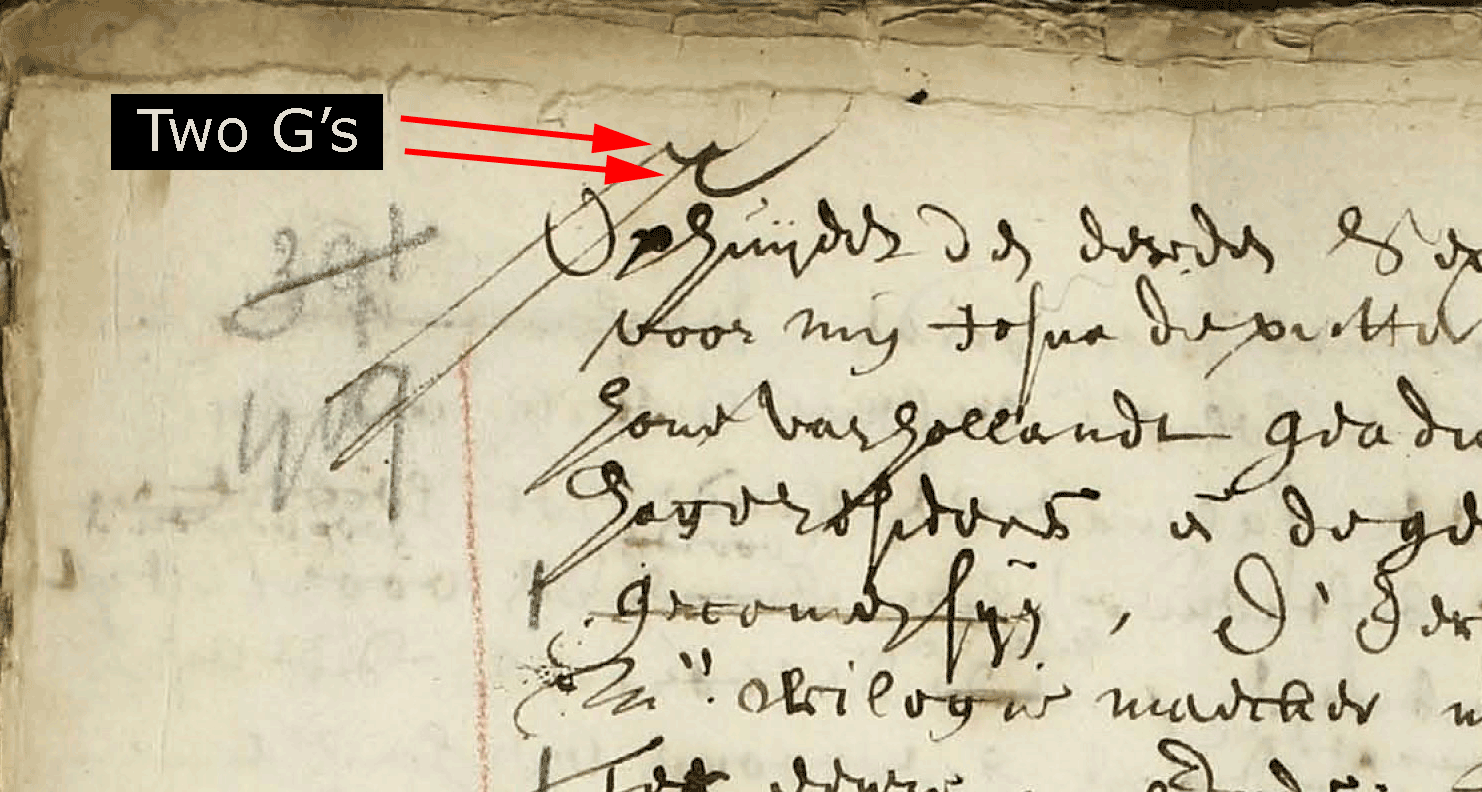
fig. 6 Two G's in the top left corner
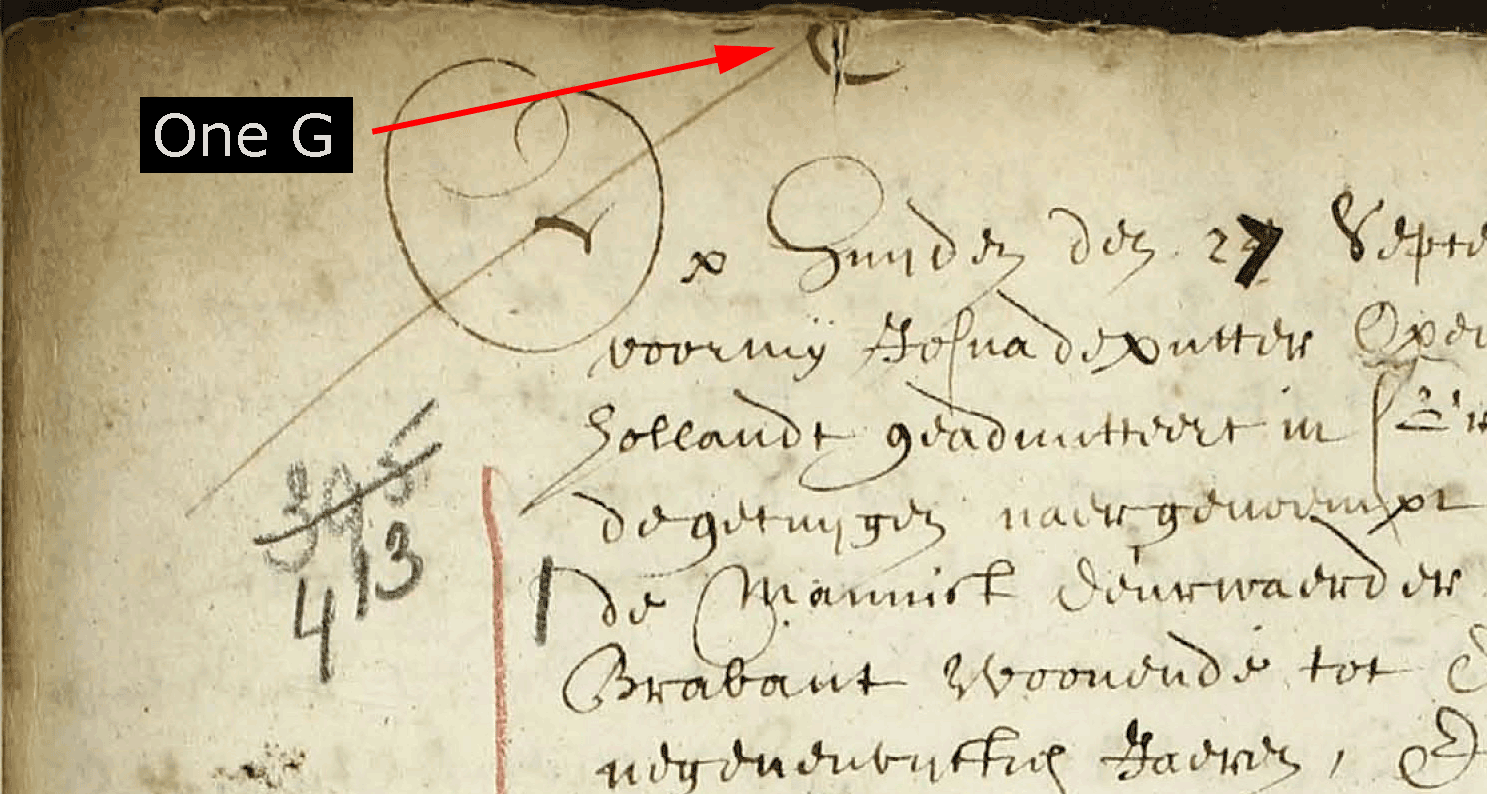
fig. 7 One G in the top left corner
 NOTARIAL
PRACTISE NOTARIAL
PRACTISE
This clarifies point I of the
introduction. Here the author states, according to the authority of Prof. Lisa
Jardin, that no legal system would have such a sloppy document filed.
However, this was common in
17th century Holland. And where were they archived? At the Court
of Holland. After all, this body admitted the notaries in Holland. So the
archives were in custody with the State. And how did they end up at the
municipality of The Hague? We quote from the
introduction of the inventory of the notarial archive in The Hague:
‘Pursuant to the authority
from the Royal Decree of 23 August 1907 (Bulletin of Acts and Decrees no. 237),
given to municipalities, that meet certain conditions, to keep the archives of
the notaries, who have had their place of employment within those
municipalities, from the central government in custody, on November 1910, the
municipality of The Hague received all archives of notaries who had resided at
its territory in the years 1597-1811 at its request on loan.’
(II
This is just an aside, for a
better understanding of the author, who asks himself in note 9 ‘How this
contract can be viewed as draft minutes and where the protocol is stored
remains unclear’. On the contrary, that is as clear as daylight.
Besides, in contrast to nowadays,
notarial deeds were not always drawn up at a chic notary office. Also changes
in the text were not initialled as they are today. A lot of these procedures even
happened in the pub. The world really looked a lot different in the 17th
century.
 READING ERRORS
READING ERRORS
Next to mistakes due to lack
of historical knowledge, there are also reading errors. The author is forced to
make use of an English translation, where the danger is that there are
differences in nuance or even differences in meaning. An example: in point K of
the introduction, the author says:
‘The contract does not spell out normal
issues which are taken for granted; for example, the cost of John’s travel to
The Hague is paid by John: Salomon will provide John’s board and lodging. So
why are beer, fire and light mentioned if they were normally supplied by masters
to their workers?’
Indeed, the agreement does
not include things that are normal. But what was normal back then? That really
was not fixed. Subsequently the author claims that Salomon would provide John ‘board
and lodgings’. But that is not what it says. It does only say that Coster
will
‘indemnify and defray Fromanteel (usually to put synonyms in
succession with beer, fire and light’
(III;
so he will provide him with beer, heating and light to be able to do his work.
This also means Coster does not provide him with accommodations and meals. So, Fromanteel
stays/sleeps elsewhere.
 HISTORICAL
KNOWLEDGE HISTORICAL
KNOWLEDGE
But there is more, maybe even
more serious. Let us again limit ourselves to some examples, because there are
a lot of mistakes and there is no room to cover everything.
Dr. John C. Taylor, an
entrepreneur and inventor, who has registered more than 400 patents worldwide, states
he has never yet lost a lawsuit about a patent worldwide. Truly a formidable
achievement that certainly commands respect. But this look-and-see statement
suggests that he also has knowledge of patent law and contracts in 17th
century Holland.
This is nothing more than a
suggestion, because apparently he does not have that knowledge. He looks at 17th
century Holland through biased 20th and 21st century
international glasses.
An important example of this
is the introduction of
the
necessary existence of a
Heads of
Agreement.
Quote:
‘Parties coming for a lawyer usually have at
the very least a Heads of Agreement worked out between them, together with a
wish to compromise to some degree to achieve a final Agreement’.(14
That may be customary
nowadays, but was this so in the 17th century? The author states it
is very common - ‘at the very least’ - so he does assume it was so at
the time. In this way he’s working towards a larger role of Fromanteel.
What did the authors want to
achieve with their entire exercise? They wanted to show that a normal agreement
of employment between Coster and Fromanteel is in fact a learning agreement
between Fromanteel and Coster, i.e. a 180 degrees rotation of roles, together
with a change in the value of the agreement itself. In our opinion the authors
have not succeeded.
Too few
arguments have been put forward for this radical change, and at the same time the
authors have disqualified themselves by showing that they have no knowledge of
17th century notarial practice in Holland.
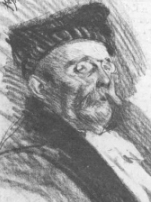 As they are unable to
read archival documents, they for instance would have done themselves and all
readers a favour to have first been informed by Prof.
Dr. Brugmans, Professor of General History.
He more than a century ago published a collection
of 180 work and student agreements from the Hague protocols.
(15 As they are unable to
read archival documents, they for instance would have done themselves and all
readers a favour to have first been informed by Prof.
Dr. Brugmans, Professor of General History.
He more than a century ago published a collection
of 180 work and student agreements from the Hague protocols.
(15
These very quickly show that
the world then did not look as unambiguous and tightly
organised as the authors suggest.
 ACKNOWLEDGEMENTS ACKNOWLEDGEMENTS
March
2019, Copyright:
(This article is subject to ongoing
revisions.)
 LINKS
LINKS
Chr.
Huygens' Œuvres Complètes.
(pdf)
Coster
Fromanteel contract.
Archive research on Salomon Coster.
Chr.
Huygens
Horologium 1658.
(pdf)
|





_full-bw.jpg)




 As they are unable to
read archival documents, they for instance would have done themselves and all
readers a favour to have first been informed by Prof.
As they are unable to
read archival documents, they for instance would have done themselves and all
readers a favour to have first been informed by Prof.